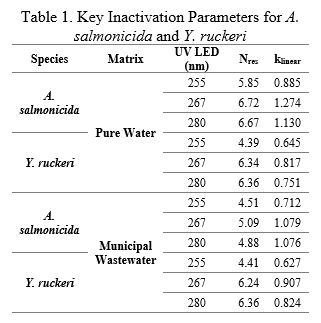UV LED DISINFECTION: A NOVEL TREATMENT FOR COMMON SALMON AQUACULTURE PATHOGENS
Both enteric red mouth disease and furunculosis (caused by Aeromonas salmonicida and Yersinia ruckeri respectively) significantly impact the aquaculture industry. Although vaccination is the most widely accepted mode of protection against these organisms, vaccination efforts are not always reliable. Traditional mercury-based UV disinfection systems have been used to effectively inactive both species; however, these systems are fragile and energy intensive, making them incompatible for use in challenging environments. Alternatively, UV light emitting diodes (UV LEDs) are durable, mercury-free point-sources of UV radiation that can be designed for output at any wavelength in the UV region. These unique features provide the necessary robustness and design flexibility to implement UV treatment within more challenging environments like open marine waters.
The objective of this project was to explore the effects of UV LED wavelength and particulate loading on the inactivation kinetics of A. salmonicida and Y. ruckeri. Batch treatments were conducted using a UV LED collimated beam apparatus at 255, 267 and 279 nm for both species suspended in either phosphate buffered solution or sterile municipal wastewater effluent. Species were enumerated using standard plate culturing techniques.
Both pathogens were highly susceptible to UV inactivation, and kinetics were species, wavelength, and matrix dependant. Table 1 highlights differences in key kinetics parameters klinear (inactivation rate constant) and Nres (upper limit of disinfection). For A. salmonicida, 267 and 280 nm treatments resulted in optimal disinfection in both matrices and was negatively impacted by particulate loading. Y ruckeri responded best to the 267 nm treatment and was slightly less susceptible to UV when compared to A. salmonicida. Furthermore, Y ruckeri was not impacted by additional particulate loading.
This study demonstrates that UV LEDs are significantly more effective for inactivation of these pathogens when compared to the traditional UV disinfection wavelength at 255 nm, and highlights the potential for use of this technology in novel disease control in a variety of aquaculture settings.
